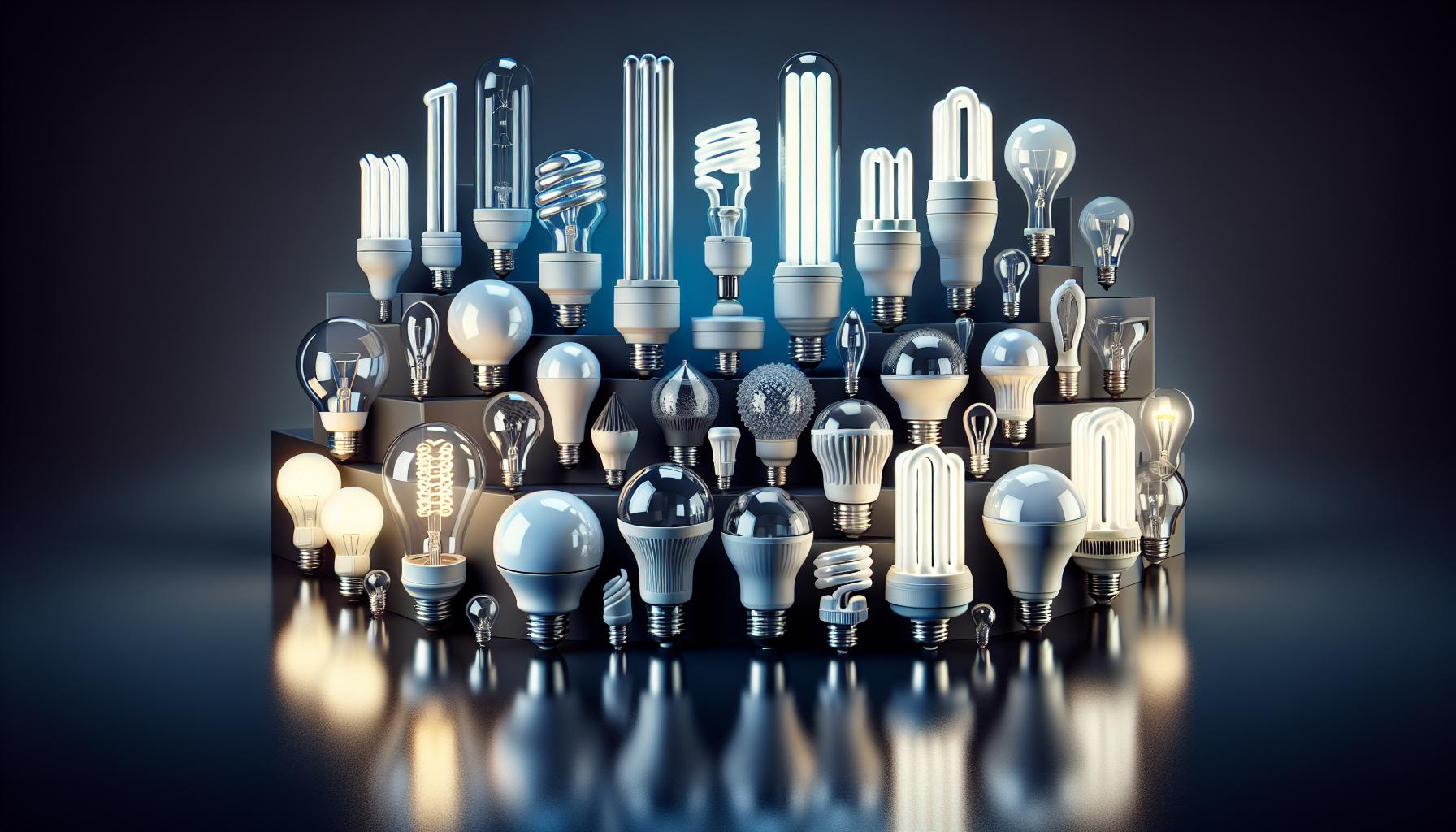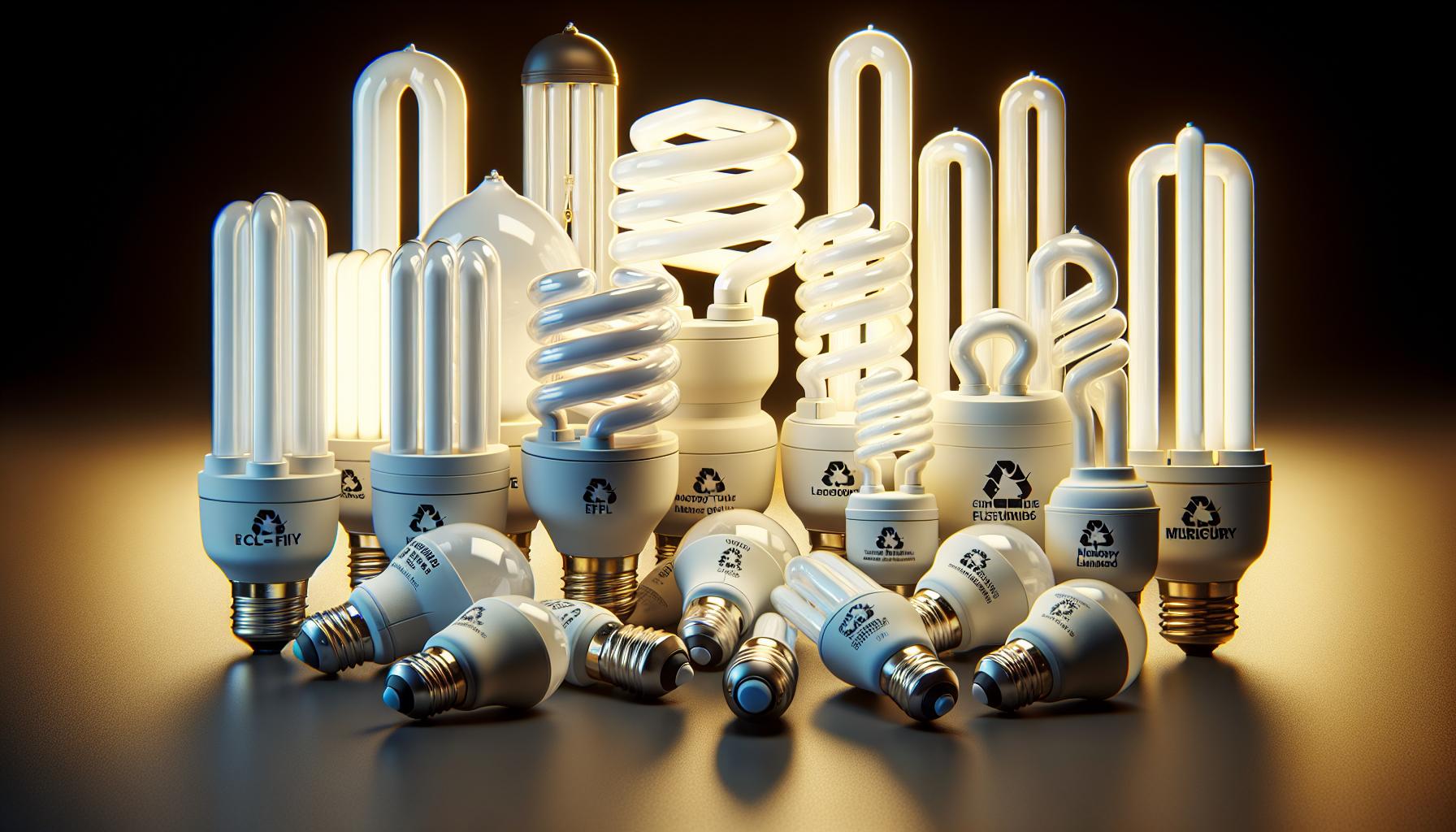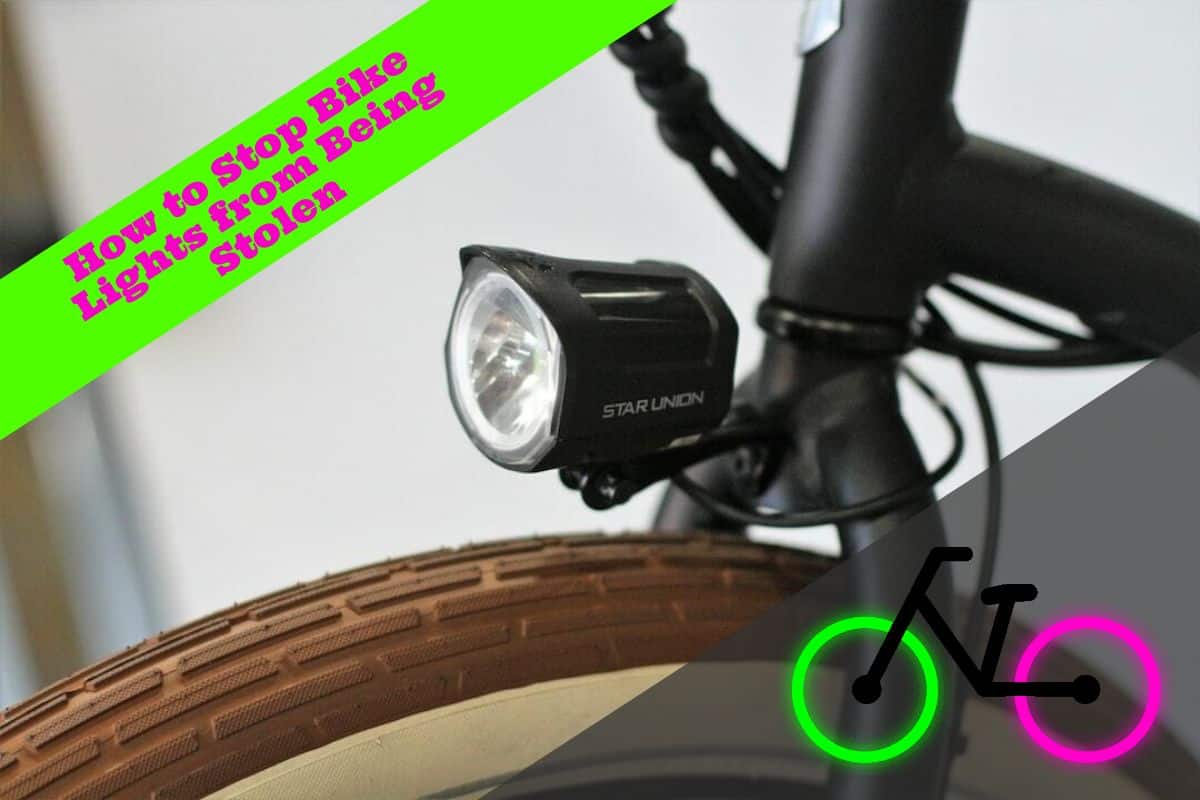Worried your light bulb might contain mercury? You’re not alone. Figuring out what’s in your light bulbs is more important than you might think, especially when it comes to disposal and environmental safety.

Don’t fret! Identifying mercury in light bulbs is simpler than it sounds. With a few quick tips, you’ll be spotting them like a pro. Stay tuned to learn how to tell if your bulbs are friend or foe to Mother Nature.
Understanding the dangers of mercury in light bulbs
When you’re knee-deep in a home DIY lighting project, the last thing you want is to unknowingly handle harmful materials. Mercury, a liquid metal at room temperature, is often used in certain types of light bulbs, such as compact fluorescent lamps (CFLs) and some linear fluorescent tubes. While it allows for the bulbs’ energy efficiency, mercury can be detrimental to both personal health and the environment if not managed correctly.
Why Should You Be Concerned?
Mercury’s link to health issues isn’t new. It’s known to be toxic, affecting the nervous system, brain, heart, kidneys, and immune system. Even small amounts can pose a threat, and it doesn’t take much mercury to contaminate air, water, and soil. Should a bulb break, the mercury contained within can vaporize, potentially leading to exposure through inhalation.
Environmental Impact of Mercury
Ecologically, mercury’s consequences are long-lasting. When it enters waterways, it’s converted into methylmercury, a compound that bioaccumulates in fish and shellfish. This, in turn, affects wildlife and humans who consume seafood. Monitoring and regulating the disposal of mercury-containing light bulbs are crucial steps in safeguarding our environment.
- Always use caution when installing or removing a light bulb that contains mercury.
- Never toss these bulbs into the regular trash.
- In the event of a breakage, ventilate the area and utilize specific cleanup procedures to minimize mercury exposure.
By staying alert and informed about the products you bring into your home—light bulbs included—you’re not only ensuring a successful DIY project but also contributing to a healthier, more sustainable environment.
Different types of light bulbs and their mercury content

Navigating the bulb aisle can feel like a puzzle. You’ve probably noticed that not all light bulbs are created equal. Let’s shine a light on the main types you’ll encounter and what they mean for mercury exposure.
Incandescent Bulbs: These are the bulbs of your grandparents’ era, emitting a warm glow reminiscent of early 20th-century homes. They typically do not contain mercury but are not as energy efficient as other options.
LED Bulbs: The new kids on the block, LEDs, are known for their energy efficiency and long life. You’ll be relieved to know that LED bulbs do not contain mercury, making them a safe bet for your DIY lighting projects.
Compact Fluorescent Lamps (CFLs): The curly, ice-cream-cone-shaped bulbs you’ve seen are CFLs. They’ve been praised for their energy efficiency, but here’s the catch: they do contain a small amount of mercury. If you’re using or disposing of these, you’ll need to take precautions.
Linear Fluorescent Tubes: These tubular bulbs are often found in office buildings and garages. Like their compact cousins, they too contain mercury, though typically more than CFLs.
High-Intensity Discharge (HID) Bulbs: Used for large areas like stadiums and streetlights, HID bulbs pack a powerful punch and, yes, you guessed it—they also house mercury.
To keep your home projects both bright and safe, it’s crucial to identify bulbs by their shape and label. Most manufacturers make it clear if the bulb contains mercury, often abbreviating it as “Hg.” If you’re still unsure, the EPA provides an online resource, or you can look for the “Mercury-Free” label as a quick guide.
Below is a quick reference of common bulb types and their mercury status:
| Light Bulb Type | Contains Mercury? |
|---|---|
| Incandescent | No |
| LED | No |
| CFL | Yes |
| Linear Fluorescent Tubes | Yes |
| HID | Yes |
Signs to look for in identifying mercury-containing light bulbs
« What Light Bulbs Go in Wax Warmers? Find the Perfect Fit
Is It OK to Store Light Bulbs in the Garage? Find Out Safe Storage Tips »

You’re well aware that efficient lighting is key to a comfortable home and can be quite a game-changer in your DIY projects. But, when dealing with light bulbs, especially when replacing or disposing of them, it’s crucial to know if they contain mercury. Here’s how to spot mercury-containing bulbs.
Firstly, look at the bulb’s shape. Compact fluorescent lamps (CFLs) usually have that telltale spiral shape or may resemble a tube folded onto itself. Long tube fluorescent bulbs are straight and typically used in office settings. Both of these types often contain mercury. If you’re working on a colossal lighting project, keep an eye out for high-intensity discharge (HID) bulbs. These are found in street lights and large spaces and are another category that typically includes mercury.
Another sign is the bulb’s label. Manufacturers are required to indicate if a bulb contains mercury. The label might be a ‘Hg’ symbol (Hg being the chemical symbol for mercury) or a statement such as “contains mercury.” In some cases, the amount of mercury is also listed, giving you an indication of the level of care you need to take during handling and disposal.
Finally, don’t ignore the eco-friendly or federal guidelines stamps. Bulbs adhering to certain environmental standards may still contain mercury but in regulated amounts. For instance, the Energy Star label might be present on bulbs that are energy-efficient but do still contain mercury. This is essential to recognize for proper disposal.
- CFLs and linear fluorescents: Spiral shape or long tubes
- HIDs: Often found in street and outdoor large area lighting
- Labels: Look for ‘Hg’ or mentions of mercury
- Eco-friendly labels: Check for regulations mentioned
As a lighting aficionado, you understand that responsible handling of these bulbs not only contributes to your safety but also helps protect the environment. Keep these signs in mind as you illuminate spaces and tackle those enlightening home projects.
How to safely dispose of light bulbs with mercury

Disposing of light bulbs that contain mercury requires special attention because improper handling can lead to mercury release, which is harmful to both your health and the environment. Moreover, as a DIY enthusiast and lighting aficionado, you understand the significance of taking care of your home and planet.
Recycling is the best option for disposal. Many municipalities have special programs for recycling, and some retailers offer recycling as a service. Firstly, you’ll need to find a recycling center that accepts bulbs with mercury. Your local waste management authority can often provide this information, or you can use Earth911’s recycling locator.
Before you recycle:
- Store bulbs carefully to prevent breakage. Use the original packaging or wrap them in newspaper.
- Transport bulbs in a rigid container, avoiding any jostling that could cause them to break.
- Seal the container and label it as ‘Contains Mercury – Handle with Care.’
If, by chance, a bulb breaks before you can recycle it, there are immediate steps to take:
- Air out the room for at least 15 minutes.
- Carefully scoop up glass fragments and powder using stiff paper or cardboard.
- Use sticky tape to pick up any remaining small pieces or powder.
- Wipe the area clean with a damp paper towel.
- Place all clean-up materials in a sealable plastic bag.
- Do not vacuum unless recommended after all other cleanup steps have been read; it could spread mercury-containing powder or vapor.
Never throw mercury-containing bulbs in the trash. It’s not just environmentally unfriendly; it might also be illegal, as many areas have regulations in place regarding the disposal of these types of bulbs.
Remember, being a light bulb enthusiast comes with the responsibility of ensuring that every bulb’s life cycle ends as safely and eco-consciously as possible. With mindful disposal practices, you’re not just brightening up your home; you’re also contributing to a brighter future for the planet.
Eco-friendly alternatives to mercury-containing light bulbs

You’re someone who cares about your environmental footprint, so it makes sense to seek out eco-friendly lighting options. You’ve got a myriad of choices that do not involve mercury, each with its own set of benefits.
LED bulbs are the frontrunners when it comes to environmentally friendly lighting. They don’t contain mercury, and they significantly reduce energy consumption, lasting up to 25 times longer than traditional incandescent bulbs.
For those of you who love the classic warmth of incandescent bulbs, you’ll be thrilled with halogen incandescents. These bulbs offer a similar look and feel but are more energy-efficient and do not contain mercury.
If you’ve a penchant for modern technology and smart home devices, consider smart LEDs. These bulbs can be controlled remotely, change colors, and can be integrated with home automation systems. Plus, they’re mercury-free and energy-efficient.
Here’s a quick glance at some eco-friendly lighting options:
| Light Bulb Type | Mercury Content | Energy Efficiency |
|---|---|---|
| LED Bulbs | None | Very High |
| Halogen Incandescents | None | High |
| Smart LEDs | None | Very High |
When it comes to shopping, always look for the Energy Star label. Bulbs that earn this label have to meet stringent energy efficiency guidelines set by the EPA and the Department of Energy. Energy Star-certified bulbs use about 70-90% less energy and as a bonus, they help to reduce greenhouse gas emissions.
Remember, the decision you make in the lighting aisle reflects directly on your energy bill and your commitment to a sustainable future. Your choices count, especially when you’re someone who loves to get involved in home DIY projects where every detail matters. Adopting energy-saving lights not only embellishes your living space but also conserves energy for the planet.
By making informed choices and switching to eco-friendly lighting, you’re not just illuminating your home—you’re ensuring a brighter future for the world. Now that’s a bright idea.
Conclusion
Recognizing whether your light bulbs contain mercury is more straightforward than you might think. You’ve got the knowledge now to spot them by shape and label and understand the significance of handling them with care. Remember the perks of switching to eco-friendly options like LED bulbs and the allure of those Energy Star labels. It’s all about making choices that benefit not only your home but also the planet. So go ahead and light up your space with confidence and a clear conscience!
Frequently Asked Questions
Do incandescent bulbs contain mercury?
No, incandescent bulbs do not contain mercury. They are considered safe from mercury-related hazards.
Which types of light bulbs contain mercury?
LED bulbs, compact fluorescent lamps (CFLs), linear fluorescent tubes, and high-intensity discharge (HID) bulbs all contain mercury in varying amounts.
How can I identify if a light bulb contains mercury?
You can identify mercury-containing light bulbs by their shape, label, and additional stamps indicating they meet eco-friendly or federal guidelines.
What should I look for when shopping for eco-friendly bulbs?
Look for the Energy Star label and consider eco-friendly alternatives such as LED bulbs, halogen incandescents, and smart LEDs.
Why is it important to switch to energy-efficient lighting?
Switching to energy-efficient lighting is important for environmental conservation, reducing energy bills, and contributing to a sustainable future.




